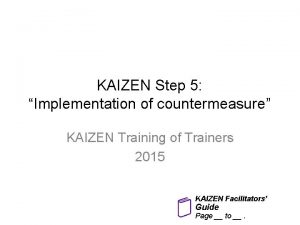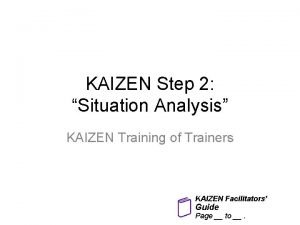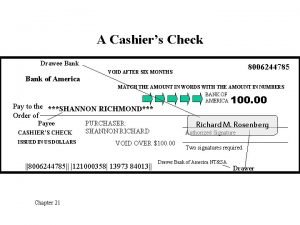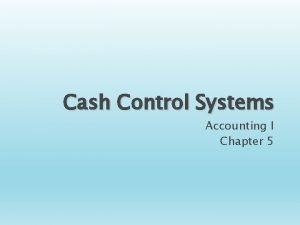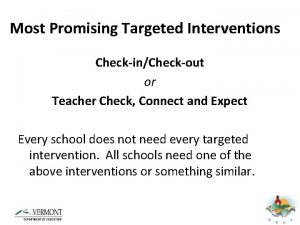KAIZEN Step 6 Check effectiveness of countermeasure KAIZEN














- Slides: 14

KAIZEN Step 6 : “Check effectiveness of countermeasure” KAIZEN Training of Trainers 2015 KAIZEN Facilitators’ Guide Page __ to __.

Objectives of the session At the end of the session, trainees are able to: 1. Describe process of effectiveness check of KAIZEN activities 2. Identify effective countermeasures 3. Demonstrate the process of effectiveness check at working environment 1

KAIZEN Process STEP Check effectiveness of countermeasure STEP 6 STEP 5 STEP 4 STEP 3 STEP 2 STEP 1 Standardization 7 Implementation of countermeasure Identification of countermeasure Root Cause Analysis Situation Analysis Selection of KAIZEN theme 2

Outline of effectiveness check 1 Situation analysis 3 2 Effectiveness check - Reduction rate - Comparison Pareto chart Relation between countermeasures and effectiveness Not implemented・ Not effective Implemented・ Not effective Not implemented ・ But effective 4 Implemented・ Effective Go to Step 7: Standardization 3

How to check effectiveness of KAIZEN • Compare frequency and reduction rate of frequency between before and after KAIZEN • Check achievement to your target set in Step 2 (reduction rate) • Compare other information in terms of: – Cost – Work labor – cost effectiveness – Quality – Work process – Human resource etc. 4

Data collection (Situation analysis after KAIZEN) • Review methods of situation analysis done in KAIZEN Step 2 • Conduct situation analysis in the same methods: – Same data – Same period of data collection – Same methodologies of data collection 5

Development of a comparison calculation table Before KAIZEN SQ # 1 2 3 4 5 Contributing factors Number of giving wrong injectable medicines Number of giving wrong inhale medicines Giving wrong oral medicines Giving wrong volume of insulin Number of giving wrong ointment Total After KAIZEN Reduction Cumulativ Accumulati Cumulative Accumulati of frequency rate (%) Frequency e Frequency on ratio (%) frequency 25 25 46. 3 7 7 46. 7 18 72. 0 16 41 75. 9 4 11 73. 3 12 75. 0 6 47 87. 0 3 14 93. 3 3 50. 0 5 52 96. 3 1 15 100 4 80. 0 2 54 100 0 15 100 2 100. 0 - - 15 - - 39 72. 2 54 Formula of reduction rate Data of before KAIZEN Data of after KAIZEN Reduction between before and after KAIZEN 6

Development of comparison Pareto chart Adjusting scale as same level of before KAIZEN 100, 0 After KAIZEN 25 100, 0 90, 0 80, 0 15 60, 0 50, 0 10 40, 0 30, 0 5 20, 0 70, 0 Frequency 70, 0 80, 0 20 Accumulation ratio (%) 20 Frequency 90, 0 15 60, 0 50, 0 10 40, 0 30, 0 5 20, 0 10, 0 0 0, 0 1 2 3 4 Contributing factor Frequency 5 Accumulation ratio (%) 0 0, 0 1 Frequency 2 3 4 Contributing factor 5 Accumulation ratio (%) Same order of “the contributing factors” between before and after KAIZEN even if the order of contributing factors is changed. 7 Accumulation ratio Before KAIZEN 25

(Example) Comparison results between before and after KAIZEN 4 5 25 46. 3 7 7 46. 7 18 72. 0 16 41 75. 9 4 11 73. 3 12 75. 0 6 47 87. 0 3 14 93. 3 3 50. 0 5 52 96. 3 1 15 100 4 80. 0 2 54 100 0 15 100 2 100. 0 - 1525 - - 39 100, 0 72. 2 90, 0 80, 0 70, 0 60, 0 50, 0 40, 0 30, 0 20, 0 10, 0 100, 0 90, 0 80, 0 70, 0 60, 0 50, 0 40, 0 30, 0 20, 0 10, 0 54 20 15 10 5 0 1 15 10 5 1 Accumulation ratio (%) Frequency 2 3 4 Contributing factor Frequency 20 Accumulation ratio 3 25 Frequency 2 Number of giving wrong injectable medicines Number of giving wrong inhale medicines Giving wrong oral medicines Giving wrong volume of insulin Number of giving wrong ointment 25 Total Frequency 1 Contributing factors Before KAIZEN After KAIZEN Reduction Cumulativ Accumulati Cumulative Accumulati of frequency rate (%) Frequency e Frequency on ratio (%) frequency Accumulation ratio (%) SQ # 2 3 4 Contributing factor 5 Accumulation ratio (%) 8

Breaking down your effectiveness • Clarify whether each countermeasures were effective or not • Relation between countermeasures and effectiveness can be categorized into 4 groups Effectiveness Implementation Effective Countermeasure implemented Countermeasure not implemented ① Not effective ② It is effective and need to be standardized It is not effective and need to review measures ③ ④ Need to clarity why it is effective Implement some measures 9 (DO something)

Cont. 1. Effectiveness should be measured by each countermeasure 2. The countermeasure that is not implemented but show good effects need to be investigated the reason 3. The countermeasure that is not implemented and cannot measure effectiveness need to be implemented 10

Cont. 3. It is necessary to review countermeasures if the countermeasures were not effective 4. The countermeasures that were implemented and judged as “effective” will be standardized in Step 7 5. The countermeasures may cause bad effects. If bad effects are greater than effectiveness, it is necessary to review the countermeasures 11

Identify effective countermeasures Which countermeasure was leading? ? Your target Expected outcome Achieved Partially achieved KAIZEN Step 7 Got worse Unexpected outcome Good effect KAIZEN Step 3, 4, 5, 6 Bad effect 12

Thank you for listening
 Step 1 step 2 step 3 step 4
Step 1 step 2 step 3 step 4 Spill prevention control and countermeasure plan template
Spill prevention control and countermeasure plan template A single countermeasure is sufficient for sqli attacks.
A single countermeasure is sufficient for sqli attacks. Countermeasure implementation
Countermeasure implementation Step 7 training
Step 7 training Kaizen process
Kaizen process Fishbone diagram kaizen
Fishbone diagram kaizen Jobbank
Jobbank Part 5 preparing a check stub and check
Part 5 preparing a check stub and check Behavior check in check out sheet
Behavior check in check out sheet Dda algorithm advantages and disadvantages
Dda algorithm advantages and disadvantages Check your progress 1
Check your progress 1 Check in check out
Check in check out Behavior check-in
Behavior check-in Check in check out system
Check in check out system



